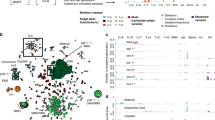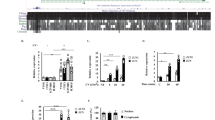Abstract
MicroRNAs (miRNAs) are important regulators of cell fate determination and homeostasis. Expression of these small RNA genes is tightly regulated during development and in normal tissues, but they are often misregulated in cancer. MiRNA expression is also affected by DNA damaging agents, such as radiation. In particular, mammalian miR-34 is upregulated by p53 in response to radiation, but little is known about the role of this miRNA in vivo. Here we show that Caenorhabditis elegans with loss-of-function mutations in the mir-34 gene have an abnormal cellular survival response to radiation; these animals are highly radiosensitive in the soma and radioresistant in the germline. These findings show a role for mir-34 in both apoptotic and non-apoptotic cell death in vivo, much like that of cep-1, the C. elegans p53 homolog. These results have been additionally validated in vitro in breast cancer cells, wherein exogenous addition of miR-34 alters cell survival post-radiation. These observations confirm that mir-34 is required for a normal cellular response to DNA damage in vivo resulting in altered cellular survival post-irradiation, and point to a potential therapeutic use for anti-miR-34 as a radiosensitizing agent in p53-mutant breast cancer.
This is a preview of subscription content, access via your institution
Access options
Subscribe to this journal
Receive 50 print issues and online access
$259.00 per year
only $5.18 per issue
Buy this article
- Purchase on Springer Link
- Instant access to full article PDF
Prices may be subject to local taxes which are calculated during checkout




Similar content being viewed by others
References
Calin GA, Sevignani C, Dumitru CD, Hyslop T, Noch E, Yendamuri S et al. (2004). Human microRNA genes are frequently located at fragile sites and genomic regions involved in cancers. Proc Natl Acad Sci USA 101: 2999–3004.
Derry WB, Putzke AP, Rothman JH . (2001). Caenorhabditis elegans p53: role in apoptosis, meiosis, and stress resistance. Science 294: 591–595.
Esquela-Kerscher A, Slack FJ . (2006). Oncomirs—microRNAs with a role in cancer. Nat Rev Cancer 6: 259–269.
Gartner A, Milstein S, Ahmed S, Hodgkin J, Hengartner MO . (2000). A conserved checkpoint pathway mediates DNA damage-induced apoptosis and cell cycle arrest in C. elegans. Mol Cell 5: 435–443.
He L, He X, Lowe SW, Hannon GJ . (2007). microRNAs join the p53 network--another piece in the tumour-suppression puzzle. Nat Rev Cancer 7: 819–822.
Hui L, Zheng Y, Yan Y, Bargonetti J, Foster DA . (2006). Mutant p53 in MDA-MB-231 breast cancer cells is stabilized by elevated phospholipase D activity and contributes to survival signals generated by phospholipase D. Oncogene 25: 7305–7310.
Iorio MV, Ferracin M, Liu CG, Veronese A, Spizzo R, Sabbioni S et al. (2005). MicroRNA gene expression deregulation in human breast cancer. Cancer Res 65: 7065–7070.
Johnson CD, Esquela-Kerscher A, Stefani G, Byrom M, Kelnar K, Ovcharenko D et al. (2007). The let-7 microRNA represses cell proliferation pathways in human cells. Cancer Res 67: 7713–7722.
Johnson SM, Grosshans H, Shingara J, Byrom M, Jarvis R, Cheng A et al. (2005). RAS is regulated by the let-7 microRNA family. Cell 120: 635–647.
Ljungman M, Lane DP . (2004). Transcription—guarding the genome by sensing DNA damage. Nat Rev Cancer 4: 727–737.
Miki Y, Swensen J, Shattuck-Eidens D, Futreal PA, Harshman K, Tavtigian S et al. (1994). A strong candidate for the breast and ovarian cancer susceptibility gene BRCA1. Science 266: 66–71.
Miska EA, Alvarez-Saavedra E, Abbott AL, Lau NC, Hellman AB, McGonagle SM et al. (2007). Most Caenorhabditis elegans microRNAs are individually not essential for development or viability. PLoS Genet 3: e215.
Runnebaum IB, Nagarajan M, Bowman M, Soto D, Sukumar S . (1991). Mutations in p53 as potential molecular markers for human breast cancer. Proc Natl Acad Sci USA 88: 10657–10661.
Salter KH, Acharya CR, Walters KS, Redman R, Anguiano A, Garman KS et al. (2008). An integrated approach to the prediction of chemotherapeutic response in patients with breast cancer. PLoS ONE 3: e1908.
Vogelstein B, Lane D, Levine AJ . (2000). Surfing the p53 network. Nature 408: 307–310.
Weidhaas JB, Babar I, Nallur SM, Trang P, Roush S, Boehm M et al. (2007). MicroRNAs as potential agents to alter resistance to cytotoxic anticancer therapy. Cancer Res 67: 11111–11116.
Weidhaas JB, Eisenmann DM, Holub JM, Nallur SV . (2006). A Caenorhabditis elegans tissue model of radiation-induced reproductive cell death. Proc Natl Acad Sci USA 103: 9946–9951.
Acknowledgements
We thank the CGC for strains. MK was supported by a postdoctoral fellowship from the Uehara Life Science Foundation. JW was supported by the Breast Cancer Alliance and a K08 grant (CA124484) from the NIH and by an American Cancer Society Institutional Research Grant to the Yale Cancer Center and by the ASTRO Junior Faculty Career Research Training Award. FS was supported by a grant from the Ellison Medical Foundation. FS and JW were supported by a grant from the NIH (CA131301-01A1).
Author information
Authors and Affiliations
Corresponding authors
Additional information
Supplementary Information accompanies the paper on the Oncogene website (http://www.nature.com/onc)
Rights and permissions
About this article
Cite this article
Kato, M., Paranjape, T., Ullrich, R. et al. The mir-34 microRNA is required for the DNA damage response in vivo in C. elegans and in vitro in human breast cancer cells. Oncogene 28, 2419–2424 (2009). https://doi.org/10.1038/onc.2009.106
Received:
Revised:
Accepted:
Published:
Issue Date:
DOI: https://doi.org/10.1038/onc.2009.106
Keywords
This article is cited by
-
microRNAs expression profile related with response to preoperative radiochemotherapy in patients with locally advanced gastric cancer
BMC Cancer (2018)
-
An integrated approach of bioinformatic prediction and in vitro analysis identified that miR-34a targets MET and AXL in triple-negative breast cancer
Cellular & Molecular Biology Letters (2018)
-
Evidence for a radiation-responsive ‘p53 gateway’ contributing significantly to the radioresistance of lepidopteran insect cells
Scientific Reports (2018)
-
cel-mir-237 and its homologue, hsa-miR-125b, modulate the cellular response to ionizing radiation
Oncogene (2017)
-
MicroRNA mir-34 provides robustness to environmental stress response via the DAF-16 network in C. elegans
Scientific Reports (2016)



